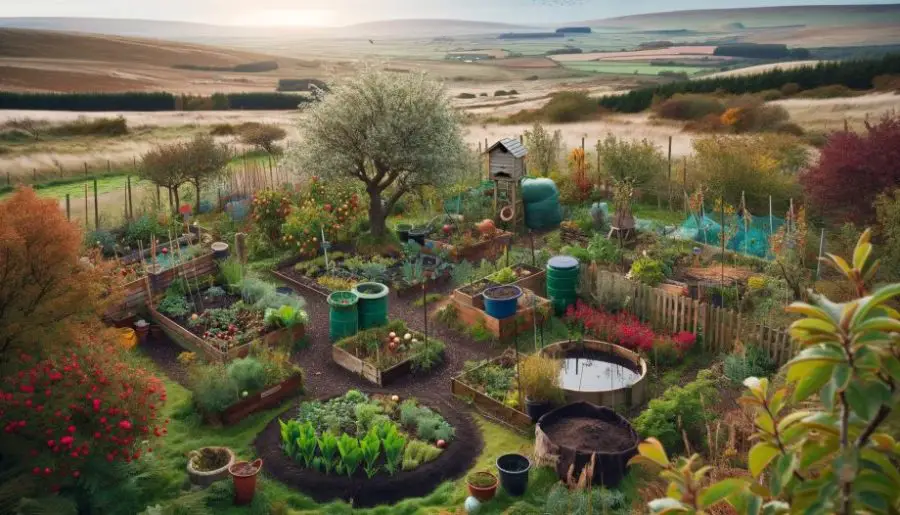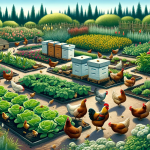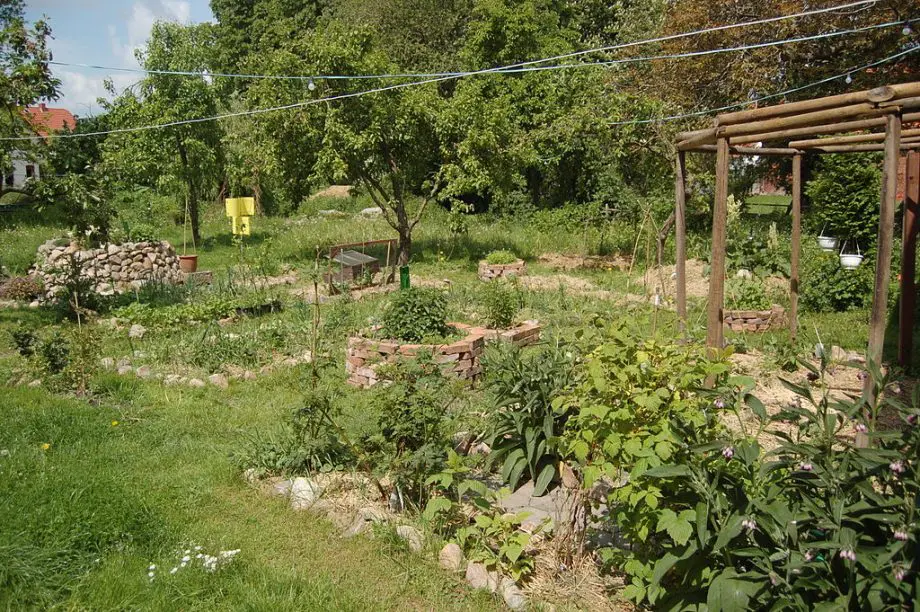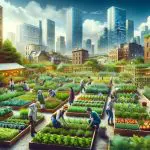
Dive into the pros and cons of permaculture with our comprehensive guide! Uncover sustainable living’s rewards and challenges.
Permaculture Pros and Cons Key Takeaways:
- Permaculture Pros and Cons: Pros include enhanced biodiversity, soil health, and water conservation.
- Cons involve high initial costs, labor intensity, and adaptation challenges.
- Permaculture promotes sustainability but requires time and effort to realize its full benefits.
Welcome to our exploration of the pros and cons of permaculture! This sustainable approach to living has sparked widespread interest, but what are its real impacts?
Join us as we uncover the truths, benefits, and hurdles of permaculture in a practical, engaging manner.
The Pros and Cons of Permaculture
Permaculture is a concept that’s becoming increasingly important in today’s world.
It’s a sustainable way of living, integrating human activity with natural surroundings to create highly efficient ecosystems.
This approach isn’t just about growing food; it’s a philosophy that encompasses a wide range of environmental and social aspects.
As we delve into permaculture, we’ll explore its numerous benefits and some challenges it faces, offering a comprehensive understanding of this innovative practice.
What is Permaculture?
Permaculture, a term that has garnered much attention in sustainable living circles, is more than just a method of gardening.
It’s a design philosophy that harmonizes human living with the natural environment.
This section explores what permaculture truly is and traces its fascinating origins.
Defining Permaculture
Permaculture is an innovative framework for sustainable living and agricultural practice.
Derived from permanent agriculture and permanent culture, it seeks to create living environments that are both sustainable and self-sufficient.
This approach involves designing landscapes that mimic patterns found in nature, aiming to create ecosystems that are diverse, resilient, and beneficial to both humans and the environment.
The Three Core Tenets of Permaculture
- Earth Care: Prioritizing the health and well-being of our planet.
- People Care: Ensuring that the systems we create are beneficial to individuals and communities.
- Fair Share: Promoting equality and limiting consumption to ensure resources are distributed fairly.
The Origins of Permaculture
Permaculture was first conceptualized in the 1970s by Australians Bill Mollison and David Holmgren.
It emerged as a response to the environmentally damaging practices of modern agriculture.
They envisioned a system of agriculture that was not only productive but also worked in harmony with nature.
This vision led to the development of principles that guide the design and implementation of sustainable living environments around the world.
Key Principles of Permaculture
Permaculture is guided by several principles, such as:
- Observation and Interaction: Understanding nature by observing and working with it, rather than against it.
- Catch and Store Energy: Utilizing natural resources like rainwater and sunlight efficiently.
- Produce No Waste: Creating systems where all elements are utilized and nothing is wasted.
- Design from Patterns to Details: Starting with a broad overview and then focusing on the specifics.
By understanding what permaculture is and where it comes from, we can appreciate its role in today’s world as a solution for sustainable and ethical living.
Part 1: Pros of Permaculture

1. Reduction of Waste
Permaculture stands out for its remarkable efficiency in resource use.
This approach prioritizes the reduction of waste, ensuring that every element within the ecosystem serves multiple purposes.
For example, plant waste is often turned into compost, which then enriches the soil.
This circular model of using and reusing resources minimizes waste output significantly, setting an example for sustainable living practices that can be applied beyond farming.
2. Improved Soil Quality
Healthy soil is the foundation of any successful permaculture system.
Techniques like composting, mulching, and cover cropping play a crucial role in enhancing soil health.
These methods increase soil fertility, improve its structure, and boost its ability to retain water and nutrients.
The result is a thriving, nutrient-rich soil that supports diverse plant life and contributes to the overall health of the ecosystem.
3. Water Conservation
Permaculture places a strong emphasis on efficient water use.
Techniques such as rainwater harvesting, drip irrigation, and the creation of swales are common practices.
These methods help in reducing water wastage, ensuring that every drop is used effectively.
By mimicking natural systems, permaculture designs can maintain moisture levels and reduce overall water consumption, making them particularly beneficial in areas facing water scarcity.
4. Increased Biodiversity
Diversity is a key element in permaculture. By incorporating a variety of plants, animals, and microorganisms, permaculture systems promote a balanced ecosystem.
This diversity not only enhances the resilience of the system but also supports a wide range of wildlife.
Increased biodiversity helps in pest control, and pollination, and maintains the overall health of the environment.
5. Resilience to Climate Change
Permaculture systems are inherently adaptable, making them well-suited to withstand the challenges posed by climate change.
The diversity and redundancy built into these systems ensure that they are resilient to extreme weather events.
Permaculture’s focus on local resources and self-sufficiency also means these systems can better cope with the impacts of global climate shifts.
6. Local Food Production
Permaculture encourages the local production of food, which reduces the reliance on industrial agriculture and long-distance transportation.
This approach not only supports local economies but also ensures fresher, more nutritious produce.
Local food production also fosters a sense of community. Living in a permaculture community people come together to grow and share food.
7. Additional Benefits
Permaculture offers a plethora of additional advantages:
- Ecosystem Services: Supports natural pollinators and pest control, enhancing crop production and ecological balance.
- Carbon Sequestration: By promoting healthy soils and perennial plantings, permaculture helps in storing carbon, thus combating climate change.
- Community Building: Permaculture projects often bring people together, fostering collaboration and strengthening local food networks.
- Lower Input Requirements: These systems minimize the need for synthetic fertilizers and pesticides, relying instead on natural processes.
- Regenerative Land Management: Permaculture contributes to rehabilitating and improving degraded lands.
- Healthier Lifestyle: Engaging in permaculture practices promotes physical activity and a healthier diet.
- Economic Benefits: By reducing reliance on purchased inputs and fostering local trade, permaculture can stimulate local economies.
- Awareness and Education: It raises awareness about sustainable practices and environmental stewardship.
Part 2: Cons of Permaculture

While permaculture offers numerous benefits, it’s important to acknowledge its challenges.
Understanding these drawbacks is crucial for anyone considering adopting permaculture practices.
In this section, we’ll explore the various cons, ranging from economic concerns to practical limitations, giving a well-rounded view of permaculture’s impact.
1. High Initial Costs
Setting up a permaculture system can be costly. The initial investment includes land preparation, purchasing perennial plants, and establishing water systems.
These costs can be a barrier, especially for small-scale farmers or individuals.
While these investments often pay off in the long term, the upfront expense can be significant and may deter some from adopting permaculture practices.
2. Short-Term vs. Long-Term Benefits
The benefits of permaculture, such as improved soil quality and biodiversity, often take time to manifest.
This delay can be challenging, particularly for those who rely on immediate returns.
Farmers transitioning from conventional to permaculture farming might face short-term yield reductions before the long-term benefits become evident, posing financial challenges during the transition period.
3. Adaptation and Acceptance Challenges
Permaculture can be a significant departure from traditional farming methods.
This new approach may face skepticism from conventional farmers and can conflict with local customs and practices.
Additionally, certain religious beliefs might not align with some permaculture practices, potentially creating social and cultural barriers to its adoption.
4. Practical Limitations
Without chemical pesticides, permaculture systems might experience increased pests and disease challenges.
There’s also a general lack of widespread knowledge and understanding of permaculture techniques, which can hinder their effective implementation.
Additionally, permaculture may not be suitable for large-scale, global food production, which poses a challenge in addressing the food needs of the growing world population.
5. Labor and Time
Permaculture often requires more manual labor and time investment compared to conventional farming.
The design and maintenance of these systems, especially in the initial stages, can be labor-intensive.
This aspect can be a deterrent for those with limited time or physical ability, making it less appealing to a wider audience.
6. Additional Challenges
- Aesthetic Considerations: Permaculture sites might appear untidy or less manicured compared to traditional gardens or farms, which can be less appealing to some.
- Lower Production: In some cases, permaculture might not be as effective in producing large quantities of food, especially in challenging environments.
- Higher Consumer Costs: Due to lower production volumes and intensive labor, products from permaculture systems can be more expensive for consumers.
- Risk of Contamination with Transgenic Crops: Maintaining a 100% natural and ecological crop can be challenging, especially with the risk of contamination from nearby conventional farms.
- Slowed Economic Growth: Shifting to permaculture could temporarily slow economic growth in regions dependent on industrial agriculture.
- Unpleasant Smell: Processes like composting can produce strong odors, which might be unpleasant for some individuals.
- Time to Realize Benefits: The positive effects of permaculture on the environment and biodiversity may take years to become evident.
The Pros and Cons of Permaculture FAQs

Permaculture is a topic rich with interest and inquiry. Here, we address some frequently asked questions, providing clear, concise answers to help deepen your understanding of permaculture.
Q: What exactly is permaculture?
A: Permaculture is an approach to land management and philosophy that adopts arrangements observed in flourishing natural ecosystems.
It involves creating sustainable and self-sufficient agricultural systems by integrating land, resources, people, and the environment.
Q: How does permaculture differ from traditional farming?
A: Unlike traditional farming, which often relies on single-crop cultivation and extensive use of chemicals, permaculture emphasizes biodiversity, ecological sustainability, and natural farming techniques.
It aims to create a harmonious, interdependent system where each element benefits the others.
Q: Can permaculture be practiced in urban areas?
A: Yes, permaculture a permaculture garden can be adapted to urban settings. Urban permaculture involves utilizing small spaces like rooftops, balconies, and backyards to create sustainable gardens.
It incorporates principles like vertical gardening, composting, and rainwater harvesting to make the most of limited urban spaces.
Q: Is permaculture a viable solution to global food security?
A: Permaculture has the potential to contribute significantly to food security by promoting sustainable agricultural practices and local food production.
However, scaling it to meet the global food demand is challenging. It works best when integrated with other sustainable farming practices.
Q: How long does it take to see the results of permaculture?
A: The timeframe to see tangible results from permaculture can vary.
Some benefits, like improved soil quality, can be seen within a few seasons, while others, like full ecosystem development, may take several years.
Permaculture is a long-term investment in sustainable land use.
Q: Can permaculture be profitable?
A: Yes, permaculture can be profitable. By reducing costs associated with inputs like fertilizers and pesticides and focusing on high-value crops and local markets, permaculture can provide a sustainable and profitable model for farmers and gardeners.
Q: How does permaculture contribute to environmental conservation?
A: Permaculture contributes to environmental conservation by promoting biodiversity, enhancing soil quality, conserving water, and reducing reliance on non-renewable resources.
Its holistic approach helps in creating ecosystems that are both productive and ecologically sound.
Advantages and Disadvantages of Permaculture Conclusion

In conclusion, permaculture presents a compelling and sustainable approach to agriculture and living, harmonizing human activity with the natural world.
While it offers numerous environmental and social benefits, it’s not without its challenges.
This balancing act between the pros and cons highlights the complexities of sustainable practices in our modern world.
Embracing Sustainability and Resilience
Permaculture’s emphasis on sustainability and resilience is perhaps its most significant contribution.
By mimicking natural ecosystems and promoting biodiversity, it creates robust systems that are less reliant on external resources and more adaptable to changing conditions, including climate change.
Economic Considerations and Long-Term Benefits
While the initial costs and labor intensity of permaculture can be deterrents, the long-term economic and environmental benefits often outweigh these challenges.
Permaculture practices lead to healthier soils, reduced water usage, and lower dependence on costly inputs, which can be economically beneficial in the long run.
Cultural and Practical Adaptations
The adoption of permaculture requires cultural and practical adaptations.
Integrating traditional farming knowledge with permaculture principles can provide a more holistic approach to agriculture, addressing food security and ecological concerns simultaneously.
Future Directions and Global Impact
Looking forward, permaculture’s role in global food security and environmental conservation will depend on its integration with other sustainable agricultural practices and technologies.
As awareness grows, so does the potential for permaculture to shape a more sustainable and resilient future.
Education and Community Involvement
Finally, education and community involvement are key to expanding the reach and impact of permaculture.
By sharing knowledge and working together, communities can implement permaculture practices effectively, leading to more sustainable and self-sufficient lifestyles.
Permaculture is not just a farming method; it’s a philosophy that rethinks our relationship with the environment.
While it faces challenges, its potential benefits for the planet and future generations make it a path worth exploring and embracing.






